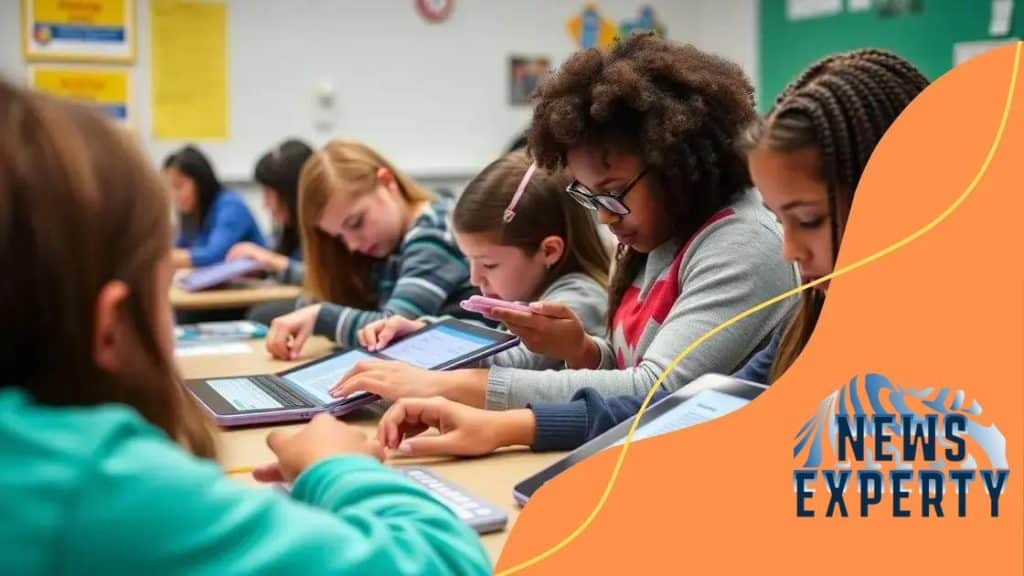The rise of digital textbooks in K-12 education

Anúncios
The rise of digital textbooks in K-12 education enhances learning through interactive content, personalized experiences, and instant access to updated materials, while addressing challenges like the digital divide and screen fatigue.
The rise of digital textbooks in K-12 education is reshaping the learning landscape. Do you ever wonder how this shift impacts students and teachers alike? Join me as we dive into this transformative trend.
Anúncios
Understanding digital textbooks
With the digital age in full swing, understanding digital textbooks is crucial for educators, students, and parents alike. These innovative resources offer a shift away from traditional paper-based materials, providing interactive and engaging learning experiences.
What are digital textbooks?
Digital textbooks are electronic versions of standard textbooks that can be accessed through computers, tablets, or smartphones. They often include multimedia elements such as videos, quizzes, and interactive content, making learning more engaging.
Benefits of digital textbooks
There are numerous advantages to using digital textbooks in the classroom. By transitioning to these formats, schools can:
Anúncios
- Reduce costs for printed materials.
- Enable real-time updates and revisions.
- Provide personalized and adaptive learning experiences.
- Enhance accessibility for all students.
Furthermore, digital textbooks can facilitate collaboration among students and teachers. With features like shared notes and linked resources, they foster a community of learners who can engage actively with the content. This interaction is vital in promoting understanding and retention of material.
How do they support learning?
Digital textbooks support learning by enriching the curriculum. They allow students to explore subjects more deeply with the inclusion of interactive elements. For instance, features like embedded videos can clarify complex topics and provide visual context.
Additionally, many platforms offer tracking tools. These tools help educators monitor progress and identify areas where students may need extra support. This data-driven approach enables targeted teaching methods, ensuring that all students can succeed.
Challenges of digital textbooks
Despite their benefits, there are also challenges associated with digital textbooks. Issues such as the digital divide, where some students lack access to necessary technology, can hinder equitable learning opportunities. Schools need to be mindful of these concerns as they implement digital resources.
Moreover, some students may find it difficult to focus on a screen for extended periods. Therefore, it’s essential to blend digital and traditional learning methods to cater to different learning preferences.
Benefits for students and educators
The benefits for students and educators using digital textbooks are substantial and transformative. These interactive resources can enhance the learning experience and improve teaching effectiveness.
Engagement and Interactivity
One of the key advantages of digital textbooks is their ability to engage students more effectively. The inclusion of multimedia elements such as videos and interactive quizzes fosters a deeper connection to the material. This engaging format not only holds students’ attention but also enhances retention of information.
Access to Updated Content
Digital textbooks can be updated easily, ensuring that students have access to the most current information. Traditional textbooks require reprints for updates, which can be costly and time-consuming. With digital formats, educators can provide accurate and timely resources without the lag associated with print.
- Instant access to new editions.
- Inclusion of recent research and findings.
- Ability to edit instructional materials on the fly.
Moreover, digital textbooks can accommodate different learning styles. Some students may benefit from visual aids, while others might prefer interactive simulations. This versatility allows teachers to meet the diverse needs of their students.
Cost-Effectiveness
Digital textbooks are often less expensive than their printed counterparts. Schools can save on printing and distribution costs, enabling them to allocate resources more efficiently. Additionally, students can benefit from these savings, as many digital resources are available at lower prices or even for free.
Access to a wide range of materials is another significant benefit. Educators can easily incorporate various resources into their teaching, from e-books to supplementary online materials, thus enriching the learning experience.
Improved Learning Outcomes
Research shows that the use of digital textbooks can lead to improved learning outcomes. They provide features such as interactive assessments and immediate feedback, allowing students to track their progress and adjust their study habits accordingly. Educators can also use analytics to identify areas where students struggle, providing targeted support.
Challenges of digital formats

While digital formats present numerous advantages, understanding the challenges of digital textbooks is essential. These limitations can impact both students and educators in significant ways.
Digital Divide
One significant challenge is the digital divide. Not all students have equal access to technology. This gap can create disparities in learning experiences. Without reliable devices or internet connectivity, some students may struggle to keep up with their peers.
Screen Fatigue
Another issue is screen fatigue. Many students spend hours in front of screens for both schooling and leisure. This fatigue can affect concentration and engagement. Teachers need to find a balance between digital and traditional resources to help alleviate this issue.
- Provide screen breaks during lessons.
- Incorporate offline assignments.
- Encourage outdoor or hands-on activities.
Additionally, while digital textbooks can be interactive, not every student adapts well to online learning environments. Some learners may prefer physical books for their tactile experience. This preference can influence their engagement and learning outcomes.
Reliability and Technical Issues
Reliability is another concern. Technical issues such as software glitches, crashes, or insufficient app support can interrupt learning. When these problems occur, they can create frustration for both students and educators. Schools must ensure proper training and support for troubleshooting.
Moreover, copyright and licensing issues can arise in digital textbooks. Educators need to navigate the complexities of using digital resources legally. This situation could limit access to a wider variety of materials, which is key for comprehensive learning experiences.
Integration in the classroom
Integration of digital textbooks in the classroom has become increasingly important as educators seek to enhance learning experiences. This approach not only modernizes teaching but also aligns with students’ digital lifestyles.
Seamless Blending of Resources
Teachers can effectively blend digital textbooks with traditional materials. Utilizing both formats allows students to engage with the content in diverse ways. For instance, a teacher might assign a chapter from a digital textbook while also incorporating hands-on activities or printed worksheets to reinforce learning.
Interactive Learning Environment
Digital textbooks facilitate an interactive learning environment. With features like embedded videos, quizzes, and links to external resources, students can explore topics in depth. This interactive approach encourages active participation, making learning more engaging.
- Use interactive quizzes to assess understanding.
- Include videos that explain complex concepts.
- Incorporate links to additional resources for deeper exploration.
Moreover, collaborative tools in digital formats enhance group work. Students can work together on projects, share notes, and provide feedback in real-time, fostering a sense of community and teamwork in the classroom.
Customization and Personalization
Another benefit of digital textbook integration is the ability to customize learning experiences. Educators can tailor content to meet the specific needs of their students. For example, if a student struggles with a concept, the teacher can assign additional readings or resources from the digital textbook to support their learning.
Additionally, digital textbooks often come with analytics that allow teachers to track student progress. This data enables educators to identify areas where students excel or need more help. By understanding how students interact with the material, teachers can adjust their instruction accordingly.
Future trends in K-12 education
Future trends in K-12 education indicate a significant shift towards embracing technology and innovative teaching methods. As schools adapt to evolving needs, several key trends are emerging.
Personalized Learning
One trend that is gaining traction is personalized learning. Educators are increasingly recognizing that students learn at different paces and in different ways. By leveraging digital tools and resources, teachers can create customized learning experiences tailored to individual needs. This approach allows students to progress at their own speed, leading to better engagement and understanding.
Increased Use of Technology
The integration of technology in classrooms will continue to rise. Tools like virtual reality, augmented reality, and artificial intelligence are becoming more common in educational settings. These technologies can provide immersive learning experiences and help students grasp complex concepts more effectively.
- Virtual tours of historical sites.
- Simulations for science experiments.
- AI tutors for personalized assistance.
Furthermore, the use of learning management systems (LMS) will facilitate more efficient classroom management and communication between teachers, students, and parents. These platforms can streamline assignments, track progress, and allow for real-time feedback.
Focus on Soft Skills
In addition to academic knowledge, there is a growing emphasis on teaching soft skills. Skills such as teamwork, communication, and critical thinking are essential for success in today’s job market. Schools are beginning to incorporate these skills into the curriculum through collaborative projects and interactive learning scenarios.
Another significant trend is the emphasis on social and emotional learning (SEL). By addressing emotional intelligence, schools help students develop resilience, empathy, and self-management. This holistic approach supports overall well-being and academic success.
Flexible Learning Environments
Lastly, the design of learning spaces is also changing. Flexible classrooms that support both individual work and group collaboration are becoming more common. These environments encourage creativity and adaptability, allowing students to learn in ways that suit them best.
As K-12 education continues to evolve, staying informed on these trends will be crucial for educators and stakeholders. Embracing change and innovation can lead to enriched learning experiences and better outcomes for students.
FAQ – Frequently Asked Questions about Digital Textbooks in K-12 Education
What are digital textbooks?
Digital textbooks are electronic versions of traditional textbooks, accessible on devices like tablets and computers, often featuring interactive elements.
How do digital textbooks benefit students?
They enhance engagement with multimedia, support personalized learning, and provide instant access to updated content.
What challenges do schools face with digital textbooks?
Challenges include the digital divide, screen fatigue, and potential technical issues that may disrupt learning.
Will digital textbooks replace traditional textbooks completely?
While they are becoming more popular, a blend of digital and traditional materials will likely continue to be used for diverse learning needs.





